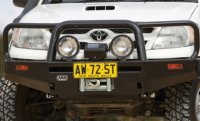
|

| News | |
09/07/2009 - BULL BAR POSITION

AAAA has recently released a position paper on bull bars outlining its strong stance on the government's recent indications that it is set to introduce new regulations regarding the manufacture and fitment of bull bars. AAAA is seeking the opportunity to provide input to government transport and regulatory policy that affects the 4WD industry. The manufacturers, distributors, retailers, fitters and drivers are all part of this industry and any discussion about increased regulation and regulations that are not consistent with national standards should involve a discussion with the industry. The Australian landscape and our broad expanse of rural roads often expose road users to encounters with animals, with the majority of serious collisions occurring in regional, rural and outer urban areas. The condition of many regional roads and our road design, which includes verges and drainage ditches running alongside major roads, increases the risk of animal strike, particularly in drought conditions. The Australian Transport Road Safety Bureau examined bull bars and road trauma (2000) and found that in the Australian environment there are positive and negative aspects of bull bars with regard to road trauma and fatal road crash data. Their final conclusion was that there is a significant lack of data on animal strikes. In their view it was impossible to isolate the effects of bull bars on pedestrians from other factors associated with injury outcomes such as vehicle size and speed. Whilst most understand the danger of hitting domestic stock and wildlife on Australian roads and understand that a bull bar will save drivers and occupant's lives, there is concern about the effect on pedestrians. However, logic dictates that it is not the bull bar that is the issue – and the transport safety agencies agree that all vehicles are a danger to pedestrians. Any pedestrian/vehicle collision will result in injury to the pedestrian and more so if the vehicle is heavy and the collision is at speed. The most common indicator of likely pedestrian harm is the speed and the weight of the vehicle not the presence of a bull bar. Pedestrians are our most vulnerable road users and yet the authorities have not imposed any pedestrian safety regulations on bicycles, motorbikes, cars, trucks, commercial or public transport vehicles. They do not require carmakers to test their vehicles for head injury to pedestrians. There are no requirements for airbags on the outside of any vehicle currently in production. Why is this? Why don't we design pedestrian friendly vehicles? The obvious answer is that pedestrians and vehicles simply don't mix. The best way to protect pedestrians is to make sure they do not come into contact with a moving vehicle. No design specification is capable of protecting a pedestrian from the harm inflicted by connecting with a one tonne moving vehicle. Due to government driver education, drivers know that the best way to protect pedestrians in urban areas is to slow down. Protecting pedestrians is a road safety issue; government authorities need to ensure that vehicles and pedestrians are kept at a safe distance from each other - urban road design, speed limits, pedestrian crossings and road safety education, save pedestrian lives. If it is accepted that no vehicle is friendly to pedestrians, why then is there so much talk about bull bars? So much discussion about banning and regulating? AAAA believes that it is because the bull bar can be seen. The response from government regulators is to seek to have bull bar mandated pedestrian safety requirements despite the fact that they do not impose pedestrian safety standards on the actual vehicle. It is disappointing when government regulators seek to impose unreasonable and illogical regulations. The consequences are that this industry must fight a rear-guard action with every transport regulator in the country. A copy of the AAAA Bull Bar Positioning Paper can be obtained by contacting AAAA head office on (03) 95617044.
|


